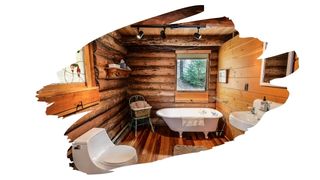Between water splash-back, steam and humidity, the bathroom provides the perfect environment for wood rot to thrive. And things can get particularly bad if your bathroom doesn’t have enough proper ventilation, allowing it to dry out.
So, in this post, you will learn why wood rot has taken hold in your bathroom. You will also find out which two products can help you save those bathroom beams from completely rotting away.

This post may contain affiliate links to products that we receive a commission for (at no additional cost to you). Learn more here.
What Causes Wood To Rot In The First Place?
When it comes to the bathroom, the main culprit is steam.
You see, wood is a natural material, one that’s also super-absorbent. If wood becomes repeatedly damp, it becomes a prime target for white wood rot. And that damp makes wood fiber an ideal home for fungi.
This is why wood finishing is such an important final step to completing any woodwork project. Wood finishing typically involves saturating wood grain with a moisture-resistant preservative (such as Linseed oil or Tung oil).
We then follow that up by applying a water-resistant top coat. This sealing top coat wraps the surface of wood, preventing moisture from getting in underneath.
However, even sealed wood can cave to wood rot. That’s because if a wooden beams water-resistant sealant coat is damaged, then moisture can soak into wood grain.
So, to keep wood rot at bay, you need to keep moisture, water, and steam vapor out of it.
Related Post: Rotting Wood Around Your Sink? 3 Ways To Protect That Wooden Worktop
Does Wood Always Eventually Rot?
Given enough time, unsealed wood will decay and degrade.
There are, however, some types of wood that are more rot-resistant than others. For example, White Oak wood and Cedar are great at shrugging off the damaging effects of damp.
Which is why these timbers are popularly used to form farmhouse style kitchens and sinks.
If You Do Nothing, How Long Will It Take For Wood To Rot Away From Water Damage? Well, completely unsealed and unpreserved timber can rot away in as little as a year (depending on the species of wood).
And Can Rotting Wood Be Saved?
You can save rotted wood by first identifying what’s causing that rot in the first place. For example, is there a broken dripping water pipe nearby? Or maybe the bathroom is poorly ventilated?
Whatever the reason, you need to sort it out before you can get to saving rotted wood. And why is that? Well, because we need to let rotted wood dry out first before we can go about fixing it. That’s because if that wooden beam is still damp, none of the following steps will work.
But, if you’ve already fixed the water leak, then give that bathroom beam a week or two to dry out. Afterwards, you can begin to take two key steps to fix it by; 1). stabilize it, and B). fill it in.
Related Post: What To Do About White Mould Under Your Hardwood Floorboards
How Do You Stabilize Rotting Wood?
The easiest way to stabilize rotting wood is to use wood hardener.
This product will save the parts of timber that haven’t been eaten away by fungi. However, it won’t be able to save sections that have already decomposed (more on solving that bit later).
Still, wood hardener will strengthen the rot-free sections of that wooden beam. And one of the best wood hardener products around is Minwax’s High Performance Wood Hardener.
This hardening solution penetrates wood grain, much like an oil finish or wood conditioner. Once it does, within 2 hours, it will have dried and solidified into a rock hard substance. And that will help preserve the integrity of all the healthy wood that still remains around those decayed sections.
You can check out the latest prices for Minwax’s High Performance Wood Hardener over here on Amazon.
How Do You Fill In Rotted Wood?
Now that the wood beam isn’t going to completely fall apart, it’s time to fill in the missing gaps. You see, wood hardener won’t fill out missing chunks of wood.
The parts that have crumbled away will need to be replaced with a tough alternative material. And an all purpose wood filler can replace what’s been lost, by packing out those gaps with an impenetrable material.
Wood filler (especially polyester wood filler) is a sandable and paintable substance that will dry almost as fast as wood hardener.
It takes less than 2 hours to solidify. And, if you get Ronseal’s Multipurpose Wood Filler product, you can purchase it in Medium Oak or Dark Brown colors too. This makes it easier to get this wood filler to blend in with the natural wood around it.
You can check out the latest prices for Ronseal’s Multipurpose Wood Filler over on Amazon.
To Wrap Up, Here Are The 3 Key Takeaways From This Post…
- 1). Wood rot is typically the result of moisture being repeatedly absorbed into wood grain.
- 2). If you don’t stop the cause of wood rot, (leaky pipes, poor ventilation, etc), it will continue to spread.
- 3). You can fix rotted wood by using wood hardener to reinforce the sections of timber that have not succumbed to rot.
References:
Identification of Anti-Wood Rot Compounds in Teak (Tectona grandis L.f.) Sawdust Extract: Journal of Wood Chemistry and Technology: Vol 28, No 4 (tandfonline.com)
